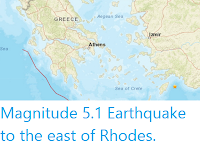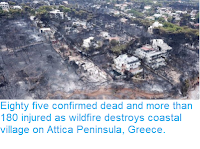The United States Geological Survey recorded
a Magnitude 6.6 Earthquake at a depth of 17.0 km, about 89 km to the south of the island of Crete, slightly after 3.50 pm local time
(slightly after 12.50 pm GMT) on Saturday 2 May 2020. No damage or
injuries have been
reported following this event, but people have reported feeling the quake on Crete.
The approximate location of the 2 May 2020 Crete Earthquake. USGS.
The island of Crete lies to the north of the boundary between the Aegean Sea Plate, which
underlies southern Greece, and the African Plate, which underlies most
of the Mediterranean. The African Plate is moving northward relative to
the Aegean Sea Plate, and is being subducted beneath it along the
Hellenic Trench, which runs from the Ionian Sea to the south and west of
the Peloponnese and then to the south of Crete. This is not a smooth process, as the plates frequently stick together
then break apart once the pressure has built up sufficiently, leading to
(fairly frequent) Earthquakes.
To the east the Arabian Plate is being pushed north and west by the movement
of the African Plate, further to the south. This leads to a zone of
tectonic activity within the province, as the Arabian and Anatolian plates are pushed
together, along the East Anatolian Fault, and past one-another, along
the Dead Sea Transform.
This movement also leads to a zone of faulting along the northern part of Turkey, the North Anatolian Fault Zone, as the Anatolian Plate is pushed past the Eurasian Plate, which underlies the Black Sea and Crimean Peninsula (transform faulting). This is not a simple process, as the two plates constantly stick together, then break apart as the pressure builds up, leading to Earthquakes, which can be some distance from the actual fault zone.
This movement also leads to a zone of faulting along the northern part of Turkey, the North Anatolian Fault Zone, as the Anatolian Plate is pushed past the Eurasian Plate, which underlies the Black Sea and Crimean Peninsula (transform faulting). This is not a simple process, as the two plates constantly stick together, then break apart as the pressure builds up, leading to Earthquakes, which can be some distance from the actual fault zone.
Simplified map of the plate movements of the eastern Mediterranean. Univeriteit Utrecht.
Witness accounts of Earthquakes can help geologists to understand these events, and the structures that cause them. The international non-profit organisation Earthquake Report is interested in hearing from people who may have felt this event; if you felt this quake then you can report it to Earthquake Report here.
See also...
Follow Sciency Thoughts on Facebook.








